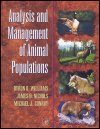About this book
The goal of this important volume is to link management, evaluation, and conservation to modeling, estimation, and decision-making methods. Four major sections review these methods and applications in science-based conservation. Part I provides a methodological framework for quantifying and modeling field observations, with special emphasis on sampling design and analysis. Part II is a comprehensive framework for dynamic modeling of populations, with examples from familiar organisms and ecosystems. Part III addresses the estimation of population attributes with sampling data, focusing specifically on the use of count data to estimate population parameters. Part IV explains decision analysis and optimal management of populations.
Contents
Preface. Part I: Framework for Modeling, Estimation, and Management of Animal Populations Introduction to Population Ecology. Scientific Process in Animal Ecology. Models and the Investigation of Populations. Estimation and Hypothesis Testing in Animal Ecology. Survey Sampling and the Estimation of Population Parameters. Design of Experiments in Animal Ecology. Part II: Dynamic Modeling of Animal Populations Principles of Model Development and Assessment. Traditional Models of Population Dynamics. Model Identification with Time Series Data. Stochastic Processes in Population Models. The Use of Models in Conservation and Management. Part III: Estimation Methods for Animal Populations Estimating Abundance Based on Counts. Estimating Abundance with Distance-Based Methods. Estimating Abundance for Closed Populations with Capture-Recapture Methods. Estimation of Demographic Parameters. Estimation of Survival Rates with Band Recoveries. Estimating Survival, Movement, and Other State Transitions with Mark-Recapture Methods. Estimating Abundance and Recruitment for Open Populations with Mark-Recapture Methods. Combining Closed and Open Mark-Recapture Models: The Robust Design. Estimation of Community Parameters. Part IV: Decision Analysis for Animal Populations Optimal Decision Making in Population Biology. Traditional Approaches to Optimal Decision Analysis. Modern Approaches to Optimal Decision Analysis. Uncertainty, Learning, and Decision Analysis. Case Study: Management of the Sport Harvest of North American Waterfowl. Appendix A: Conditional Probability and Bayes' Theorem. Appendix B: Matrix Algebra. Appendix C: Differential Equations. Appendix D: Difference Equations. Appendix E: Some Probability Distributions and Their Properties. Appendix F: Methods for Estimating Statistical Variation. Appendix G: Computer Software for Population and Community Estimation. Appendix H: The Mathematics of Optimization References. Index.
Customer Reviews
Biography
Byron Kenneth Williams is Chief of the Cooperative Research Units, U.S. Geological Survey, where he oversees a national program of research units at 39 universities in 37 states. Prior to his current position he was Executive Director of North American Waterfowl and Wetlands Office, U.S. Fish and Wildlife Service, where he served as the Co-chair of the North American Waterfowl Management Plan Committee, Coordinator of the North American Wetlands Conservation Council, and Administrator of the North American Wetlands Conservation Fund. Dr. Williams established the Vermont Cooperative Fish and Wildlife Research Unit at the University of Vermont, where he served for 6 years as the Unit Leader with a collateral faculty appointment as Associate Professor. Previous positions also include the Assistant Chief and Acting Chief of the Office of Migratory Bird Management, U.S. Fish and Wildlife Service, and several positions at the Patuxent Wildlife Research Center in Laurel, Maryland as a scientist and science manager. Dr. Williams received BS and MA degrees in mathematics from Oklahoma University, an MS degree in statistics from Colorado State University, and a Ph.D. from Colorado State University in range ecology. He is a member of the American Association for the Advancement of Science, Biometric Society, Ecological Society of America, and The Wildlife Society. He is widely published in areas as diverse as adaptive harvest management, biological modeling, multivariate statistics, vertebrate mapping, waterfowl management, scientific methodology, endangered species conservation, habitat conservation, population monitoring, and dynamic optimization in natural resource management. James Nichols received a B.S. in Biology from Wake Forest Univ., M.S. in Wildlife Management from Louisiana State Univ., and Ph.D. in Wildlife Ecology from Michigan State Univ. He has spent his entire research career at Patuxent Wildlife Research Center working for the U.S. Fish and Wildlife Service, the National Biological Service, and now the U.S. Geological Survey. He is currently a Senior Scientist at Patuxent. His research interests focus on the dynamics and management of animal populations and on methods for estimating population parameters. Michael Conroy is with the U.S. Geological Service, where he holds a position as Assistant Unit Leader in the Georgia Cooperative Fish and Wildlife Research Unit at the University of Georgia. He received B.S. and M.S. degrees in wildlife ecology and management from Michigan State University, and Ph.D. in Forest Biometrics from Virginia Polytechnic Institute and State University. His research interests are (1) development of statistical methods for the estimation of population parameters and the testing of biological hypotheses about populations; (2) extension of decision theoretic methods to conservation decision making; and (3) development of adaptive decision support systems. Dr. Conroy has taught numerous courses in quantitative ecology and biometrical methods, and has published widely in such journals as Biometrics, Paleobiology, Ecological Applications, Journal of Wildlife Management, Ecological Modelling, and Auk.


































